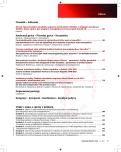Quality indicators of the Czech National Marrow Donors Registry for 2013 and comparisons with previous years
Authors:
K. Steinerová 1,2; L. Houdová 3; P. Jindra 1,2; D. Lysák 1; H. Pittrová 2; J. Navrátilová 1,2; M. Hrabětová 1; S. Vokurka 1
Authors‘ workplace:
Hematologicko-onkologické oddělení FN Plzeň
1; Český Národní Registr Dárců Dřeně, Na Roudné 12 /212, 01 00 Plzeň
2; NTIS – Nové technologie pro informační společnost, Fakulta aplikovaných věd, Západočeská univerzita v Plzni
3
Published in:
Transfuze Hematol. dnes,20, 2014, No. 4, p. 136-140.
Category:
Comprehensive Reports, Original Papers, Case Reports
Overview
At the beginning of 2014 over 24 million of unrelated donors being listed in the registries worldwide and number of hematopoietic stem cell collections exceed 16 000 per year. In order to insure the quality of unrelated donor searches Quality Assurance Working Group at the World Marrow Donor Association defined global key performance indicators for bone marrow donor registries, which were retrospectively evaluated also within Czech National Marrow Donors Registry. The aim of the study was evaluate the performance of quality indicators, perform further analysis for those that do not meet the specified criteria and compare the observed result with published data. For the year 2013 three of the five analysed quality indicators were fulfilled: the rate of extended typing performed within two weeks of receipt of the request, the rate of donors available during work up examination and the rate of discrepant typing identified in the verification typing. Two quality indicators were not fulfilled: the rate of samples of the donors available during verification typing (79% in the CNMDR compared to 80% WMDA recommended) and the rate of samples sent for verification typing within two weeks from receipt of the request (64% in the CNMDR compared to 80% WMDA recommended). Due to this unfulfilled indicators reasons for the unavailability of the donors were analysed and the lack of contact was identified as the main reason. Looking at the detail we identified the risk group of donors with only contact address and phone number provided upon entry to the registry. On the contrary minimum of unavailable donors were in the group of donor with e-mail contact. Based on the findings of unfulfilled quality indicators further quality improvement objectives were defined for the future.
Key words:
transplantation, indicator, unrelated, donor registries, HLA typing
Sources
1. Passweg JR, Baldomero H, Gratwohl A, Bregni M, Cesaro S, Dreger P et al.The EBMT activity survey: 1990-2010. Bone Marrow Transplant 2012; 47: 906-923.
2. http://www.worldmarrow.org (accessed on 1. Sep 2014)
3. Lown RN, Marsh SGE, Switzer GE, Latham KA, Madrigal JA and Shaw BE. Ethnicity, length of time on the register and sex predict donor availability at the confirmatory typing stage. Bone Marrow Transplantation 2014; 49: 525-531.
4. Lown RN, Shaw BE. Beating the odds: factors implicated in the speed and availability of unrelated haematopoietic cell donor provision. Bone Marrow Transplant 2013; 48: 210-219.
Labels
Haematology Internal medicine Clinical oncologyArticle was published in
Transfusion and Haematology Today

2014 Issue 4
Most read in this issue
- The significance of heavy/light chain immunoglobulin pairs (Hevylite™) in multiple myeloma
- Retransfusion system with integrated double filtration – parameters of product quality
- Activity of Blood Transfusion Service in the Czech Republic 1989–2013
- Pharmacokinetics as a tool for optimising the treatment of patients with haemophilia
